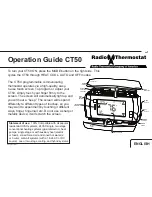
Page 95
Emissivity
thermoMETER CTL
14.
Emissivity
14.1
Definition
The intensity of infrared radiation, which is emitted by each body, depends on the temperature as well as on
the radiation features of the surface material of the measuring object. The emissivity (
e
– Epsilon) is used as
a material constant factor to describe the ability of the body to emit infrared energy. It can range between 0
and 100 %. A “blackbody” is the ideal radiation source with an emissivity of 1.0 whereas a mirror shows an
emissivity of 0.1.
If the emissivity chosen is too high, the infrared thermometer may display a temperature value which is much
lower than the real temperature – assuming the measuring object is warmer than its surroundings. A low
emissivity (reflective surfaces) carries the risk of inaccurate measuring results by interfering infrared radiation
emitted by background objects (flames, heating systems, chamottes). To minimize measuring errors in such
cases, the handling should be performed very carefully and the unit should be protected against reflecting
radiation sources.
14.2
Determination of Unknown Emissivity
- First of all, determine the current temperature of the measuring object with a thermocouple or contact sen-
sor. The second step is to measure the temperature with the infrared thermometer and modify the emissiv-
ity until the displayed measuring value corresponds to the current temperature.
- If you monitor temperatures of up to 380 °C you may place a special plastic sticker (Part number: TM-ED-
CT emissivity dots) onto the measuring object, which covers it completely.
Now set the emissivity to 0.95 and take the temperature of the sticker.
Afterwards, determine the temperature of the adjacent area on the measuring object and adjust the
emissivity according to the value of the temperature of the sticker.
- Cover a part of the surface of the measuring object with a black, flat paint with an emissivity of 0.98.
Adjust the emissivity of your infrared thermometer to 0.98 and take the temperature of the colored sur-
face.
Afterwards, determine the temperature of a directly adjacent area and modify the emissivity until the
measured value corresponds to the temperature of the colored surface.
i
On all three methods the object temperature must be different from the ambient temperature.
















































